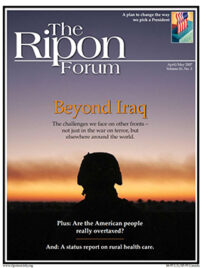
When North Korea conducted a small nuclear explosion last October, it was not only an act of defiance. It was also a confirmation that Pyongyang’s nuclear weapons program poses a clear and present threat to the regional security of East Asia, U.S. national security interests, and the global nonproliferation regime.
In the face of this defiance, many analysts and policymakers believe that North Korea will never abandon its nuclear weapons program despite its previous commitment to achieve a nuclear-free Korean peninsula. North Korean government officials and media frequently have mentioned that a nuclear free peninsula was the “dying wish of the Great Leader Kim Il Sung,” the former leader who was declared the country’s “eternal president” in September 1998 even though he had been deceased for four years.
While many discount the credibility of Pyongyang’s statements and the official goal of denuclearization, North Korean leaders clearly recognize that their country will never be secure as long as it has a hostile relationship with the United States. Kim Jong Il and his advisors probably prefer a non-nuclear peninsula in exchange for amicable relations with Washington and a regional security arrangement that credibly guarantees Pyongyang’s security interests. However, North Korea is prepared to settle for what it perceives to be its second best outcome – a deployed nuclear arsenal and its concomitant costs.
The Bush Administration finally appears to recognize the structural reality of nuclear diplomacy with North Korea, and we are now “back to the future” with an approach that looks more like Perry process than anyone would have expected…
In 2001, the Bush administration implemented a review of U.S. policy towards North Korea. The administration basically rejected the Clinton administration’s “Perry process,” which did not begin until late 1999 after the Congress had passed legislation requiring the appointment of a “North Korea policy coordinator.” The Clinton administration’s North Korea policy had been criticized as being in disarray when former Defense Secretary Bill Perry released a review of U.S. policy toward North Korea, the so-called “Perry Report,” in October 1999.
In sum, the Perry process recognized that Washington has a multitude of concerns regarding Pyongyang’s behavior, but Perry established a hierarchy of problems to be resolved: first the nuclear program, then ballistic missiles, followed by chemical and biological weapons, conventional arms, political issues and human rights, etc. The Perry process also established two options for North Korea: peaceful co-existence if Pyongyang were to address Washington’s security concerns; or, increasing animosity, and the real possibility of war, if U.S. concerns were ignored.
The Bush administration’s subsequent policy differed from the Perry process in three important ways. First, it essentially abandoned Perry’s hierarchical and step-by-step approach in favor of seeking a comprehensive “big deal” covering weapons of mass destruction, missiles, conventional arms, human rights, etc. Second, the Bush administration’s willingness to coexist peacefully with North Korea was in doubt for various reasons, but particularly because many inside and outside the administration viewed the comprehensive policy objectives as unachievable without “regime change.” And third, the Bush administration refused to negotiate bilaterally with Pyongyang, citing the Agreed Framework, which was signed by Washington and Pyongyang in 1994 to denuclearize Korea, as the type of bad outcome generated by U.S.-North Korea bilateralism.
The Bush policy was admirable because it addressed more U.S. concerns, including human rights, and North Korea’s illicit activities, such as smuggling and counterfeiting. Furthermore, the administration emphasized that North Korea’s nuclear weapons program threatened not only the United States, but all of East Asia. Washington eventually was able to convince Pyongyang to join the Six-Party Talks and sign a Joint Statement in September 2005 that stipulated North Korea’s commitment to abandon “all nuclear programs at an early date.” The new agreement was “more for more” compared to the Agreed Framework, and it seemed to make the six parties – the United States, China, Japan, North Korea, South Korea, and Russia – better off.
However, the problem with any such complex international agreement is that it contains several steps or transactions, and the international system has no third-party to enforce contracts. Structurally, this presents two issues that international negotiators must address: the sequencing of transactions, and credible commitment problems. The party to any deal naturally wants his receivables prior to delivering his responsibilities under the contract. But with no third-party enforcer, how can the second party be sure the first party will not renege on his commitment to deliver as promised? Anyone receiving his benefits first has a strong incentive to walk away. To overcome this problem, the Agreed Framework contained a number of small transactions that were designed to build trust between the United States and North Korea over time so that denuclearization could be achieved after a period of at least 10 years.
The Bush approach to the problem was to form a coalition and apply pressure on North Korea until Pyongyang capitulated and abandoned its nuclear ambitions. Make no mistake — pressure is necessary. Unfortunately, it is also not sufficient for any strategy designed to persuade North Korea to denuclearize. The Bush administration has been very successful in applying pressure on North Korea, but Pyongyang will never give up its nuclear weapons willingly without a face-saving exit that includes negative security assurances and some package of economic incentives.
Fortunately, the incentives (both positive and negative) now appear to be well structured for the denuclearization of the Korean peninsula. The deal on the table is good for North Korea and the other five parties, but the details of sequencing and credible commitments remain and must be negotiated. The Bush administration finally appears to recognize the structural reality of nuclear diplomacy with North Korea, and we are now “back to the future” with an approach that looks more like the Perry process than anyone would have expected when the “second North Korean nuclear crisis” emerged in October 2002. The future denuclearization process will not be easy, even though an “action plan” was announced on February 13, 2007, to begin practical steps for North Korea’s denuclearization. Six-party diplomacy and the complexity of “more for more” exacerbate the problems of sequencing and credible commitments.
Nevertheless, U.S. policymakers and diplomats must remain focused because the cost of failure is very high. A second Korean War is practically unthinkable, so the fallback position for failing to roll back the nuclear program will likely be containment and deterrence. However, this outcome is also practically unthinkable because it could lead to the unraveling of the nuclear nonproliferation regime, the transfer of North Korean nuclear materials or technologies to other states or terrorists, or the use of North Korean nuclear weapons in a future conflict.
–###–
Dr. Daniel A. Pinkston is the Director of the East Asia Nonproliferation Program and a Korea specialist at the Center for Nonproliferation Studies in Monterey, California.




